Names like Pluot, Aprium and Peacotum are not typos or Pokémon, but complex fruit hybrids of the Prunus plants that are sweet.
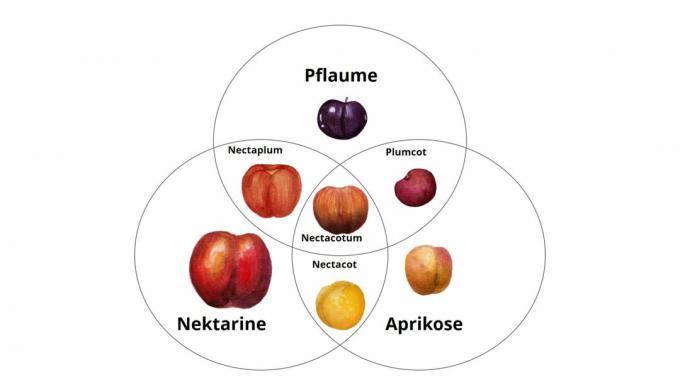
The crops that we know today were grown in this way by man for thousands of years. It is thanks to this breeding work that today we can enjoy a huge selection of fruits, grains and vegetables. But is there a possibility nowadays to “create” new fruits with classic breeding methods without having to work on them for 1000 years?
contents
- Pluots & Co: The result of the Zaiger family
- Aprium ((Apricot x Plum) x Apricot)
- Nectacot (Nectarine x Apricot)
- Nectacotum (Nectarine x Apricot x Plum)
- Nectaplum (Nectarine x Plum)
- Peacharine (Peach x Nectarine)
- Peacotum ((Peach x Apricot) x Plum)
- Pluerry (Plum x Cherry)
- Plumcot / Biricoccolo (Plum x Apricot)
- Pluot ((Plum x Apricot) x Plum)
Yes there is! In the plant world there is a specialty that produces new fruits and plants through simple crossing. While crosses between two different species are very rare in the animal kingdom, different types of plants can be crossed with one another much more easily. It is true that animals such as a horse and a donkey can give birth to offspring, but the resulting mule is sterile and cannot reproduce. However, this is not a problem with many plant species. And it is even possible to cross between more than two species! This form of breeding is called interspecific hybrids in technical terms and especially in the case of all sides popular prunus plants such as apricot, plum and peach, this breeding technique works very well Well. If different types such as plum and peach are crossed with one another, completely new fruit shapes, colors and taste combinations are possible. It is important that this is a natural process that must not be confused with plants genetically modified in the laboratory.
Pluots & Co: The result of the Zaiger family
The Zaiger family from California in particular has dedicated itself to interspecific breeding with plums, apricots and the like. Multiple awards and with a lot of know-how, a wide variety of varieties are also bred for the hobby gardener. The fruits of the Zaiger family are characterized above all by their special colors and an intensely sweet aroma. In Germany, too, a few tree nurseries already offer interspecific hybrids. A particularly well-known variety is the Pluot®, a hybrid of Chinese plum (Prunus salicina) and the apricot (Prunus armeniaca). The sugar content in particular benefits from this cross. The sweet fruits are therefore very popular with children, because the acidity is also very low. This variety is perfect for children who often avoid fruit because of its sour taste. However, anyone who thinks that interspecific breeding has already exhausted everything is wrong. The Russian variety with the simple name GEK consists of 4 different species. Among them are those Cherry plum (Prunus cerasifera), the Chinese plum (Prunus salicina) and two game species. With this variety, the high resistance to cold and fungal diseases should definitely be mentioned. But also the beautiful and harmonious tasting yellow fruits are not to be despised.
In the following we show you an overview of different hybrids such as Aprium, Pluot and Peacotum.
Let us seduce you into a world of sweet and juicy new varieties.
Aprium ((Apricot x plaround) x apricot)
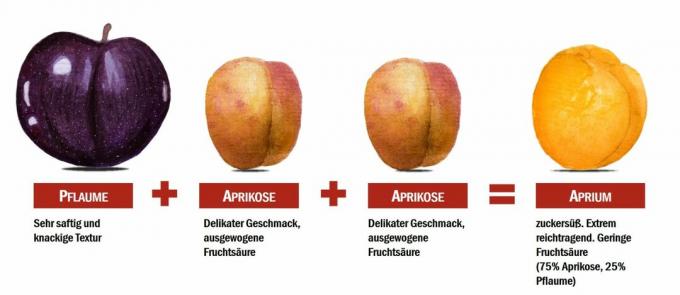
Another very interesting breed is the Aprium. This variety is also a hybrid of Japanese plum and apricot. In contrast to the Pluot, emphasis was placed on a large proportion of apricots. So aprium has more properties than apricot. The variety is particularly attractive for hobby gardeners in this country, as it is frost-hardy down to -22 ° C and has a compact habit. As you can already guess, the aromas of the apricot are in the foreground and the plum taste only comes through in the finish. As with the Pluot varieties, the aprium fruits are characterized by their intense aroma and pronounced sweetness. Well-known aprium varieties are Cot-n-Candy, Flavor Delight, Leah Cot and Summer Delight. With the exception of the aprium variety Flavor Delight (which sprouts very early), all varieties are suitable for cultivation in Germany.

Nectacot (Nectarine x Apricot)
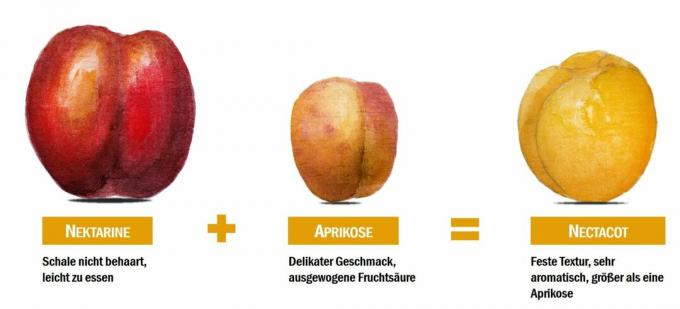
Nectacot is a cross between apricot and nectarine. The fruits are significantly larger than apricots, mostly hairless and taste like apricots with a certain fruit acidity. The pulp has a much firmer texture than classic nectarines.
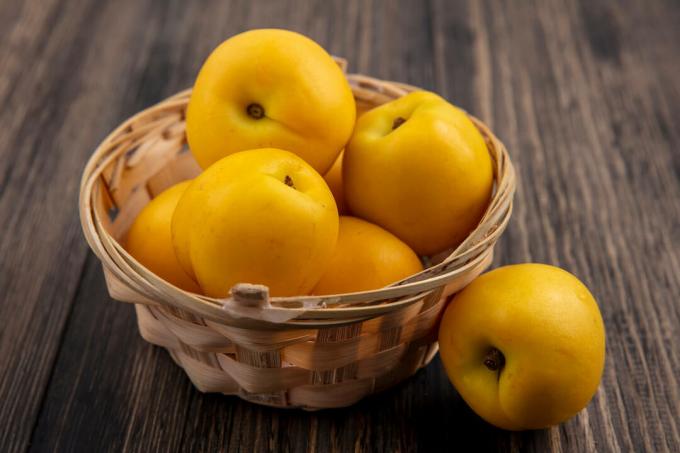
Nectacotum (Nectarine x Apricot x plaround)
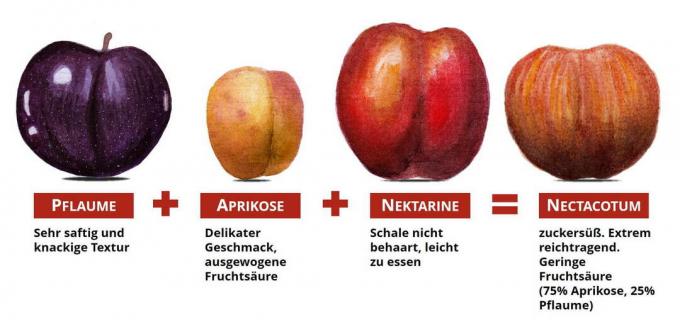
The cultivation Nectacotum is very similar to the Peacotum. Only the skin is darker and completely free of "hair".
Nectaplum (Nectarine x Plum)
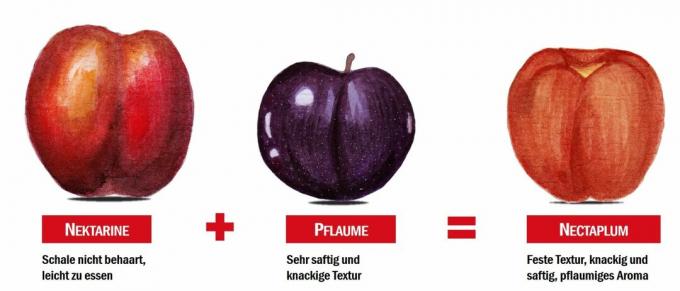
If you cross Japanese plums and nectarine, you get the nectaplum. Except for the slightly more matt color, the nectaplum is similar to the nectarine. In the taste, however, you can clearly see the proportion of plums. The Spice Zee variety is extremely rich and has an excellent taste.
Peacharine (Peach x Nectarine)
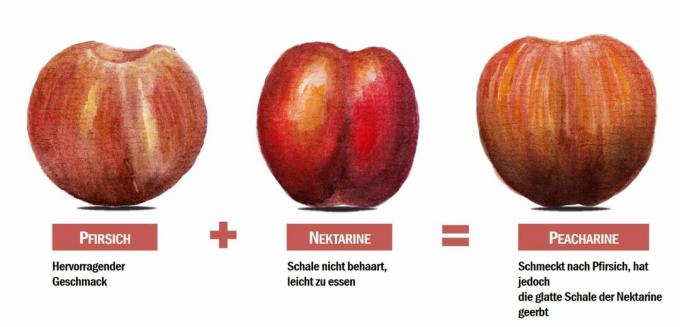
This cross between peach and nectarine comes very close in taste to a yellow-fleshed peach. However, the skin of the fruit is mostly hairless. The stone can also be removed very easily.
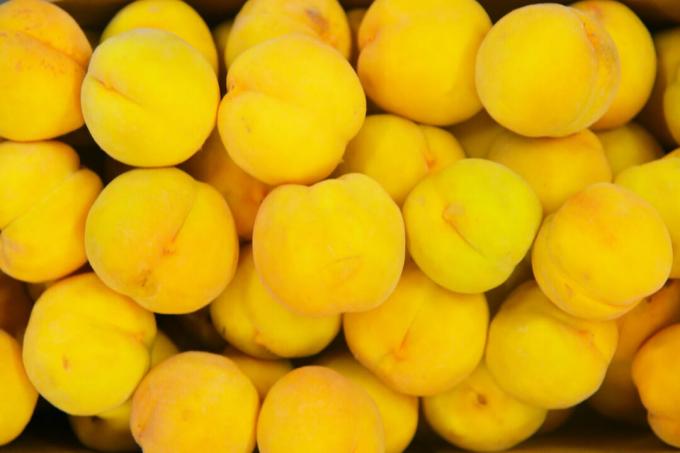
Peacotum ((Peach x Apricot) x plaround)

One of the newest breeds from Zaiger Genetics. Bella Gold Peacotum is a complex hybrid of peach, apricot and plum (Peach x Apricot x plaround). The skin is slightly hairy, the flesh is firmer than that of a peach and is reminiscent of an apricot. The texture is very crisp and juicy. In general, the Peacotum grows quite compact.
Pluerry (Plum x Cherry)

Of course, the cherry must not be missing from the many crosses of the Prunus family! The Pluerry family of varieties has characteristics of both a cherry and a Japanese plum. This should give the mostly yellow-fleshed fruits a very special aroma. The sweetness of the cherry in particular is said to lead to a real taste explosion in the fruits of the Pluerry. Popular varieties of Pluerry are Sweet Treat, Candy Heart, and Sugar Twist.
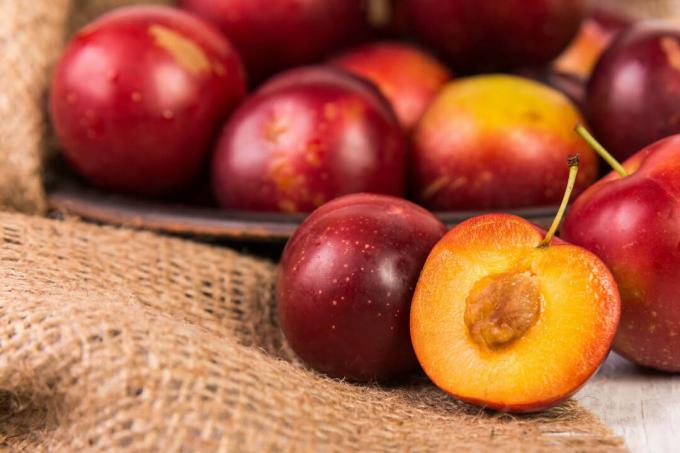
Plumcot / Biricoccolo (Plum x Apricot)
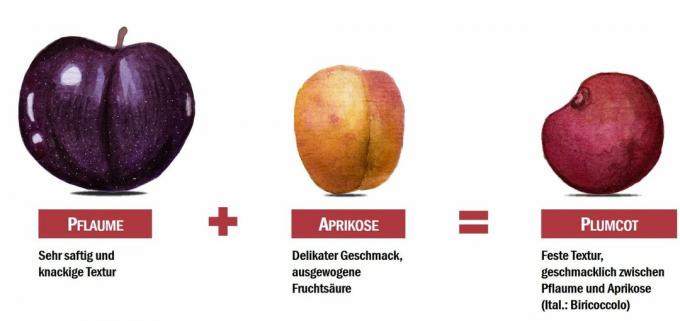
While the other hybrids come from breeding programs, there are also natural crosses in nature Cherry plum (Prunus cerasifera) and apricot. This species is called Plumcot in America and Biricoccolo in Italy.
The Zaiger company also offers some varieties of plumcots which, in our opinion, contain the Japanese plum. Well-known varieties are Flavorella, Plum Parfait, Sprite Cherry-Plum and Cherry-Plum. The last two went from crossing of cherry plum (Prunus cerasifera) with (Prunus salicina).

Pluot ((Plum x apricot) x plum)
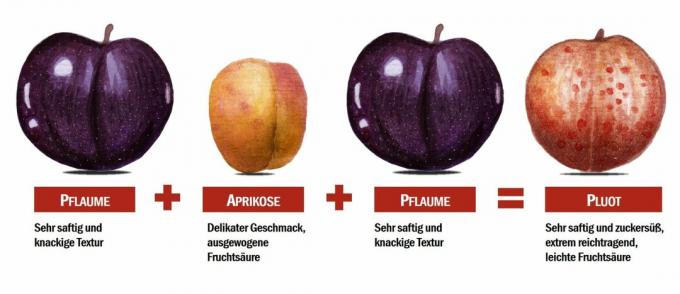
The so-called pluots are a cross between apricot and Japanese plum, which in turn was backcrossed with a Japanese plum. In other words, the Pluot is 75% Japanese plum and 25% apricot. Pluots are particularly known for their extremely high yield and their sugar-sweet fruits. While apricots have a sugar content of 11 ° Brix, the pluots have a sugar content of over 20 ° Brix. The pluots are so successful that they have been used to create other varieties such as Flavor Supreme and Purple Candy. While the Flavor Supreme variety has a gray-green skin, the Purple Candy variety has a deep purple color. What all Pluot varieties have in common, however, is that the fruits are extremely sweet and at the same time very juicy.

The small selection of varieties presented here in no way reflects the complete variety of varieties of the interspecific Prunus hybrids. When shopping in the supermarket, however, it is definitely worth taking a close look at the names of the varieties. Because there is not always just one type of apricot or plum behind the supposed apricot or plum, but rather complex cultivars with a completely new flavor experience and a very special sweetness.
